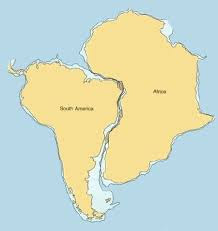Days 126-127: Sea Days - Cruising The Bay Of Guinea Towards Senegal
For the next few days, we're sailing over 1,000 nautical miles from Ghana to Dakar, Senegal, across the Bays Of Guinea and Sierra Leone. This part of the world has always fascinated me, even when I was a young kid into geography. I remember taking a world map and carefully cutting out the shapes of Africa and South America. Then I slid them together - and .. wow .. they fitted! I thought I had made major scientific discovery at age 7.
Alas, I was only 150 years late to determine one of the most visible signs of plate tectonics. But here's what happened. Up to 200 million years ago, Antarctica was joined to South America, Africa, India, and Australia as a huge supercontinent called Gondwanaland.
Then, they split up, like leaving a party. Antarctica left first, and other landmasses drifted away until only South America and Africa remained. They parted company, quite amicably, somewhere around 80 million years ago, forming what we now call the South Atlantic Ocean. The picture above shows the quite remarkable geological match, even eons later. (Geek fact: now a smaller part of East Africa is rifting away from the main continent. In 10 million years, the Horn of Africa will become its own sub-continent. The splits are already appearing, so buy up land in Uganda and Zambia for your descendants, as that will be the new coastline.
Back to the present day. There are 54 African countries, and we'll have a good
half-dozen or more of them on our starboard side as we sail west and then north to Senegal. That includes Benin, Togo, Ghana, Ivory Coast, Liberia, Sierra Leone, Guinea, Guinea-Bissau, and Gambia, plus the eland-locked countries of Mali, Burkina Faso, and Niger hiding in the interior.
This area of the world has a long history. Starting 3/4 million years ago, our partly human ancestors hung out here. As the climate changed, the population moved from coastal areas to inland areas, forming forest/desert boundaries. About 15,000 years ago, the locals became farmers, domesticated some animals, and crafted the first examples of pottery. Later, in a piece of history totally unknown to me, multiple huge and powerful empires controlled vast swathes of land and trade routes. Present-day Ghana had an empire that lasted a thousand years, from 200 to 1200 AD, that was followed by the Mali/Mandinka empire, then the mighty Songhai, and finally the Oyo (1600 to 1790).
In parallel, the Portuguese started exploring the African coastline in the mid-1400s and reached what we now call Senegal in 1445. The other European superpowers, plus the Swedes and Danes, soon followed, laying the foundations for the mass colocalization of the area. The only place that remained uncolonized was Liberia - although they made massive land concessions to stay that way. This brought about entire countries/tribes and kingdoms based on the slave trade. In essence, they sold their own people, or those they conquered, into slavery.
Once the slave trade ended, the French and British put some effort into education and numeracy. One by-product was a better-educated community, who redirected their frustrations into work for independence. Grudgingly, the colonial powers gave way, starting with the UK granting Ghana independence in 1957. Others followed suit over the next decades.
Previous blog posts have detailed the trials and tribulations of independence. Generally, that resulted in a descent into political chaos, civil wars, socialism/communism for 10-15 years, and then a move to a loose form of democracy.
So - bring on Senegal. After the last few stops, which have been emotionally tough because of the poverty and scars of colonialism and slavery - we're both going to take a fun trip.

.png)
.png)



Comments
Post a Comment
Please leave a comment (and let us know who you are!!)